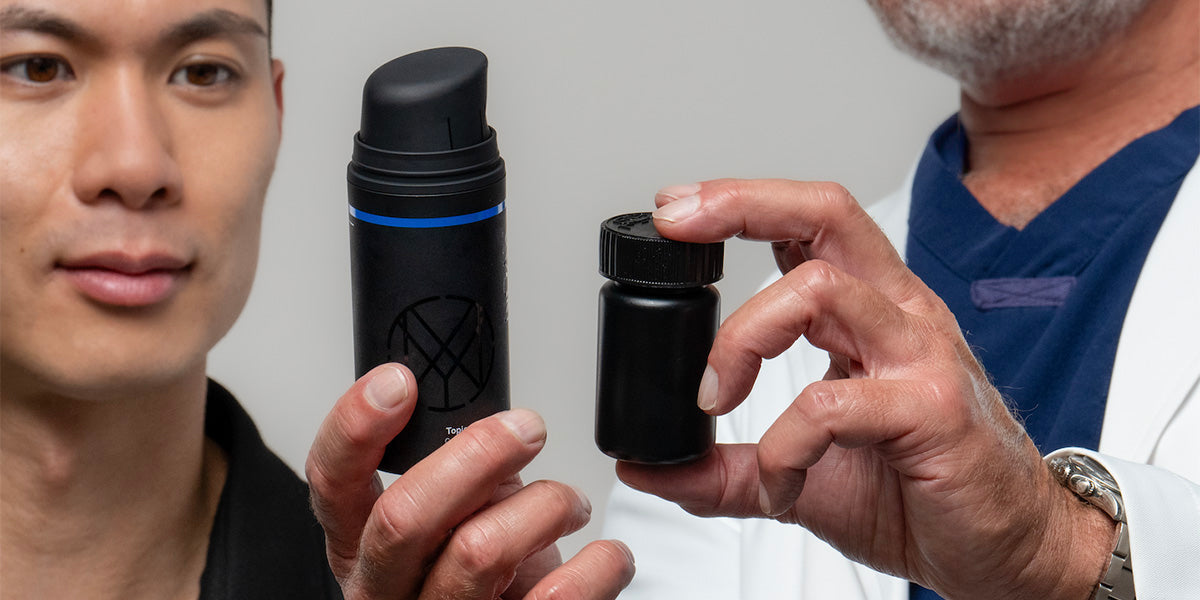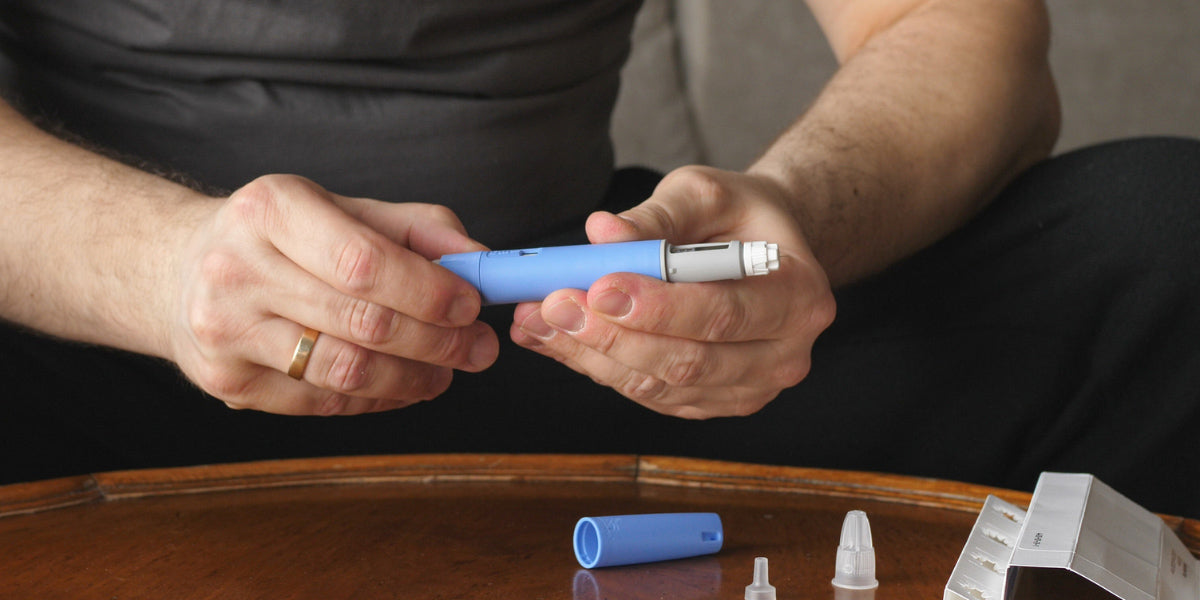DHT blockers are some of the most talked about, doctor recommended and clinically proven solutions for combatting thinning hair. What are they, how do they work, and how can you make the most of this treatment?
What is DHT?
Dihydrotestosterone (DHT) is a type of hormone called an androgen. Androgens are traditionally considered male sex hormones because they have significant effects on male health. DHT is produced in androgen sensitive tissues, such as the prostate gland and hair follicles. It’s closely related to the hormone testosterone.
DHT is made when testosterone contacts an enzyme in the body called 5-alpha reductase (5-AR). The 5-AR enzyme comes in three different forms and all help facilitate the chemical reaction that transforms it into DHT. This is significant because DHT is a more potent hormone than testosterone. It’s more likely to attach to cells (a concept called “affinity”) and cause biological changes. These changes can be good or bad. For example, during puberty, DHT is responsible for the development of body and facial hair. But later in life, especially in men who are genetically predisposed to balding, it can cause hair to thin and fall out prematurely.


At XYON, we believe in choices when it comes to hair loss treatment.
Whether it's a shampoo or a prescription, we're committed to helping you find the right solution.
What is a DHT blocker?
This is where DHT blockers come in. DHT blockers are another name for a class of medications called 5-alpha reductase inhibitors (5-ARIs). 5-alpha reductase inhibitors work by attaching to the 5-AR enzyme, preventing testosterone from being able to connect to it. This stops testosterone from being converted into DHT and for people who have a family history of hair loss or are experiencing the early signs of thinning hair, this can be hugely beneficial.
Androgenetic alopecia, or pattern hair loss, is a genetic condition. People at highest risk for losing their hair are usually also more sensitive to the effects of DHT. 5-ARIs work by preventing production of DHT and keeping DHT concentrations low for as long as a patient keeps taking the medication. Less DHT around means fewer opportunities for the hormone to attack hair follicle cells, causing them to shrink and leading to the classic signs of pattern baldness. The two best known examples of DHT blocking medications are finasteride and dutasteride.
In addition to these pharmaceutical examples of DHT blockers, there are some natural ingredients like saw palmetto and red clover extract that also seem to prevent DHT formation. Saw palmetto is probably the most significant natural DHT blocker to date, with effects that have been compared to finasteride based on a few small-scale trials. However, the proven efficacy of finasteride and dutasteride and we have significantly more information about recommended dosing and long-term safety implications.
Do DHT blockers really work?
Available clinical data suggests that as far as treatment for androgenetic alopecia goes, DHT blockers do work. Some of the strongest data that we have on their efficacy comes from comparative trials, meaning studies that look specifically at how different treatments perform against each other. One meta-analysis compared DHT blockers finasteride and dutasteride against another very popular hair loss treatment, minoxidil (sold commercially under the brand name Rogaine®). Minoxidil is not a DHT blocker and promotes hair growth using different mechanisms.
The analysis involved reviewing over twenty different studies and found that oral dutasteride and finasteride were both more effective than both oral and topical formulations of minoxidil at improving hair counts after 24 weeks of treatment (Gupta et al., 2022). Results were dose dependent, meaning higher doses of the same treatment tended to produce more dramatic hair growth results.
In a retrospective study of the long-term effectiveness of 5-ARIs, dutasteride was found to significantly improve baseline hair loss scores in 80.8% of study participants compared to 47.8% who took finasteride (Choi et al., 2022). Although it might seem like finasteride was less effective, it’s important to point out that most participants in the study were starting with moderate to moderately severe hair loss, which can be more challenging to treat.
So why exactly are DHT blockers so effective? It comes down to the DHT lowering capabilities of these medications. Dutasteride blocks two forms of the 5-AR enzyme, while finasteride only blocks one form. Dutasteride and finasteride have been shown to lower blood DHT concentrations by 98% and 71% respectively (Clark et al., 2004). A separate study found that dutasteride and finasteride could reduce scalp levels of DHT by 51% and 41%, respectively (Zhou et al., 2019). The key point is that by lowering production of DHT, these treatments play an important role in delaying the onset and progression of pattern hair loss.
What is the best DHT blocker?
The answer is that it depends on the patient. Both finasteride and dutasteride can be very effective in slowing the progression of hair loss and giving hair a chance to regrow, but there are a few factors that your doctor may consider when helping you decide between the two. These could include your medical history, whether you’ve already tried one of these medications, your personal tolerance and risk for side effects and what fits best into your daily routine.
Because dutasteride blocks two forms of the 5-AR enzyme, some people may find that it works better than finasteride. One possible explanation for why is that it might have something to do with the distribution of these two types of enzymes in the hair follicles. If someone has more type 1 5-AR compared to type 2 5-AR, their response to dutasteride could be better compared to finasteride.
What happens if I stop taking DHT blockers?
One caveat that many people miss about DHT blockers and hair loss is that once you start taking one of these medications, you’ll likely need to continue taking it for the rest of your life. After all, pattern hair loss is a progressive condition. If you’re genetically predisposed to losing your hair, there isn’t a miracle cure that will prevent this process from happening.
DHT blockers work by blocking production of DHT. If you consistently take finasteride or dutasteride, these medications can help maintain DHT levels at these new lower levels, up until the point at which you stop taking your treatment. At that point, DHT production will return to normal, but hormone levels won’t return to baseline immediately. It’s a gradual process that could take a few days or weeks, but the point is that once DHT levels start to increase, hair follicle shrinkage starts up again and will progress at a rate dictated by your genetics. This is the main reason why it’s important that you take your hair loss treatments as prescribed and as consistently as possible.
DHT blockers for hair loss: takeaway
If you’re experiencing pattern hair loss, DHT blockers are a clinically proven solution that can effectively delay the progression of hair loss and allow hair regrowth to occur. They’re a class of medications also known as 5-alpha reductase inhibitors and they work by preventing testosterone from being converted into dihydrotestosterone (DHT). This is important because DHT is a primary cause of hair loss in genetically susceptible men and when levels are left unchecked, this hormone can result in damage to hair follicles.
Today, there are many options for DHT blockers, including finasteride and dutasteride, which are available as oral medications, or topical compounded formulas. Natural DHT blockers do exist and a great example is saw palmetto extract. While these kinds of ingredients may not be a substitute for finasteride or dutasteride, they can play a supporting role in any comprehensive regimen against hair loss. If you’re experiencing hair loss, don’t delay. Consider talking to a doctor or other healthcare professional about what your options are—a DHT blocker could be the difference between keeping and losing your hair.
References List
Choi, G. S., Sim, W. Y., Kang, H., Huh, C. H., Lee, Y. W., Shantakumar, S., Ho, Y. F., Oh, E. J., Duh, M. S., Cheng, W. Y., Bobbili, P., Thompson-Leduc, P., & Ong, G. (2022). Long-term effectiveness and safety of dutasteride versus finasteride in patients with male androgenic alopecia in South Korea: a multicentre chart review study. Annals of Dermatology, 34(5), 349–359. https://doi.org/10.5021/ad.22.027
Clark, R. V., Hermann, D. J., Cunningham, G. R., Wilson, T. H., Morrill, B. B., & Hobbs, S. (2004). Marked suppression of dihydrotestosterone in men with benign prostatic hyperplasia by dutasteride, a dual 5alpha-reductase inhibitor. The Journal of Clinical Endocrinology and Metabolism, 89(5), 2179–2184. https://doi.org/10.1210/jc.2003-030330
Gupta, A. K., Venkataraman, M., Talukder, M., & Bamimore, M. A. (2022). Relative Efficacy of minoxidil and the 5-α reductase inhibitors in androgenetic alopecia treatment of male patients: a network meta-analysis. JAMA Dermatology, 158(3), 266–274. https://doi.org/10.1001/jamadermatol.2021.5743
Zhou, Z., Song, S., Gao, Z., Wu, J., Ma, J., & Cui, Y. (2019). The efficacy and safety of dutasteride compared with finasteride in treating men with androgenetic alopecia: a systematic review and meta-analysis. Clinical Interventions in Aging, 14, 399–406. https://doi.org/10.2147/CIA.S192435




